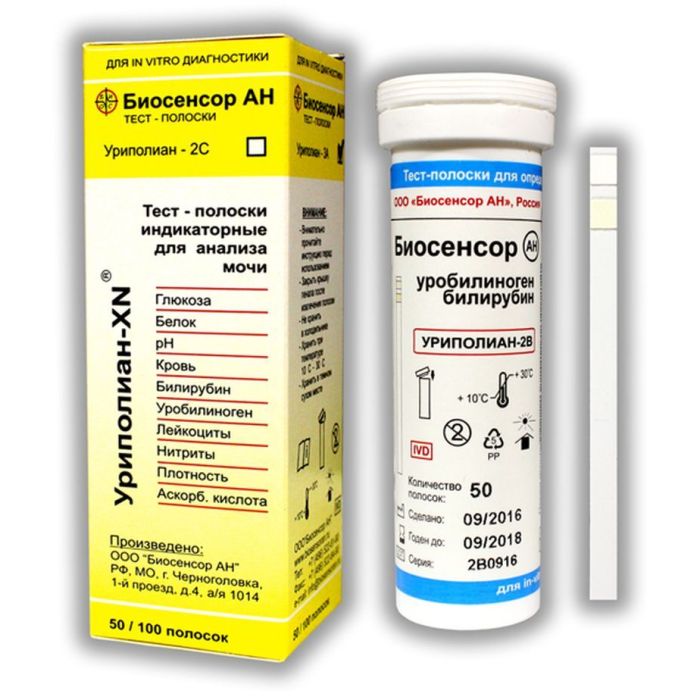Visual test strips 'Uripolian-2V' No. 50
Amount in a package
fifty
Manufacturer country
Russia
Brand name
Biosensor AN OOO
A type
Test strips
Package weight, g
31
50 tests per box
PURPOSE
Indicator test strips Uripolian-2V are intended for the qualitative and semi-quantitative determination of bilirubin, urobilinogen in urine in medical institutions, as well as at home (for express analysis of in vitro diagnostics).
Applications - self-testing, clinical laboratory diagnostics, clinical medicine, emergency express diagnostics.
Qualitative and semi-quantitative determination of bilirubin, urobilinogen in urine is used as an auxiliary method, which makes it possible to control the level of the 2 above-mentioned analytes (parameters) of urine, as well as control the course of treatment of many pathologies, including the kidneys and urinary tract.
Urine is the end product of the kidneys, which is one of the main components of metabolism and reflects the state of blood and metabolism.
It contains water, metabolic products, electrolytes, trace elements, hormones, desquamated tubule cells and urinary tract mucosa, leukocytes, salts, mucus.
The set of physical and chemical parameters of urine, as well as the analysis of the content of various metabolic products in it, makes it possible to assess not only the function of the kidneys and urinary tract, but also the state of some metabolic processes, as well as to identify violations in the work of internal organs.
Bilirubin:
The method of determination is based on the formation of a complex of diazonium salt with bilirubin (threshold of sensitivity 9.0 Ојmol / L or 0.3 mg / dL).
A slight pink coloration of the sensory zone of the test indicates a positive pathological result.
Other constituents of urine (the presence of urobilinogen above 100 Ојmol / L) form a more or less intense yellow coloration of the sensory zone.
In this case, it is recommended to read the test 2 minutes after wetting the touch area.
False positive results can be obtained in urine samples from patients taking medications that stain the urine in shades of red.
A false negative result can be caused by a high concentration of ascorbic acid (more than 500 mg / l).
Urobilinogen:
The determination is based on the reaction of urobilinogen with p-dimethylaminobenzaldehyde with the formation of a colored red complex (threshold of sensitivity 17.5 Ојmol / l).
The urobilinogen level of 33-35 Ојmol / L is a critical indicator, reflecting the transition from normal to pathology.
Factors influencing the Ehrlich reaction do not affect the sensory zone of the test.
A large amount of bilirubin can quickly turn the sensory area yellow, which can change after about a minute.
Test strips are intended for in vitro diagnostics.
Test strips are for single use only.
Potential risk class - 2a.
DEFINITION
To determine, use freshly collected (no more than 2 hours before analysis) urine in a clean dish, not centrifuged and thoroughly mixed.
1. Control at a temperature (+ 15� + 30 ° С).
2. Open the case or open the bag, remove the test strip from it.
If the test strips are packaged in a pencil case, immediately close the lid tightly.
3. Submerge the test strip sensor (s) completely in the urine.
4. After 2-3 seconds, remove the Test Strip and remove the excess urine on the sensor (s) by gently touching the edge of the strip to clean filter paper (clean paper towel, paper towel, toilet paper, etc.) for 2 -3 seconds.
5. Place the test strip on a flat, dry surface with the sensor element (s) facing up.
6. After 1 minute from the moment of immersion of the sensory element (s) in urine, compare its color with the corresponding color scale in good light.
!
Registration of the obtained analysis results can be carried out visually.
!
Do not compare the color of the sensor element with the color scale in direct sunlight.
!
During the test, do not touch the sensor elements of the Test Strip with your hands.
A change in the color of any sensory element (s) indicates the presence of one of the analytes (parameters) in the urine (qualitative determination).
Semi-quantitative determination is carried out by comparing the color of the sensor (s) element (s) with the corresponding color scales.
The label contains color scales, consisting of a number of color fields, next to each of which the concentration of the corresponding analyte (parameter) is indicated.
Changes in color, which can only occur at the edges of the sensory area (edging), are not diagnostic.
!
Strict adherence to the instructions for use is essential to obtain reliable results!
CONDITIONS OF STORAGE, OPERATION AND DISPOSAL OF THE PRODUCT
Test strips should be stored in the manufacturer's packaging in a dry place at temperatures up to 30 В° C (in the absence of acid, alkali and organic solvent vapors) for the entire shelf life of 24 months.
Biochemical research of water should be carried out at a temperature of + 10- + 35 В° C.
Improper storage and use will result in the loss of functionality of the test strips.
Keep out of the reach of children.
It is necessary to protect the indicator strips from high humidity and direct sunlight.
Avoid direct sunlight on the color scale.
Each indicator strip is designed for one determination.
After opening the case, the indicator strips should be used within no more than 5 months.
The test strip taken out of the package should be used for analysis within 15 minutes.
Do not use after the expiration date.
In case of testing after use, all components and packaging should be thrown into the waste container.
Specifications
Amount in a package
fifty
Manufacturer country
Russia
Brand name
Biosensor AN OOO
A type
Test strips
Package weight, g
31

